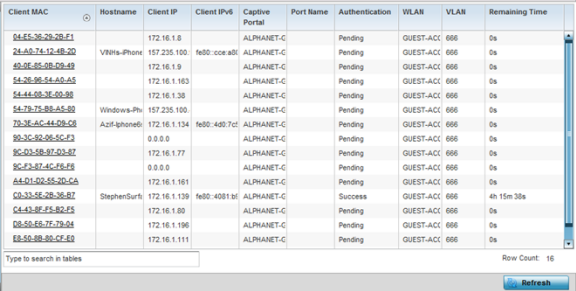A captive portal is an access policy for providing temporary and restrictive access to the controller or service platform managed wireless network. Captive portal authentication is used primarily for guest or visitor access to the network, but is increasingly being used to provide authenticated access to private network resources when 802.1X EAP is not a viable option. Captive portal authentication does not provide end-user data encryption, but it can be used with static WEP, WPA-PSK or WPA2-PSK encryption.
To view the captive portal statistics for RF Domain member devices:
The System node expands to display the RF Domains created within the managed network.
The RF Domain statistics menu displays in the right-hand side of the screen, with the Health tab selected by default.
The Captive Portal screen displays.

| Client MAC | Displays the MAC address of each listed client requesting captive portal access to the controller, service platform or AP managed network. This address can be selected to display client information in greater detail. |
| Host Name | Displays the administrator-assigned hostname of the device requesting captive portal access to the network‘s RF Domain resources. |
| Client IP | Displays the IPv4 formatted address of each listed client using its connected RF Domain member AP for captive portal access. |
| Client IPv6 | Displays any IPv6 formatted address of any listed client using its connected RF Domain member AP for captive portal access. IPv6 is the latest revision of the IP (Internet Protocol) designed to replace IPv4. IPV6 provides enhanced identification and location information for computers on networks routing traffic across the Internet. IPv6 addresses are composed of eight groups of four hexadecimal digits separated by colons. |
| Captive Portal | Lists the name of the RF Domain captive portal currently being utilized by each listed client. |
| Port Name | Lists the name virtual port used for captive portal session direction. |
| Authentication | Displays the authentication status of requesting clients attempting to connect to the controller, service platform or AP via the captive portal. |
| WLAN | Displays the name of the WLAN the requesting client would use for interoperation with the controller, service platform or AP. |
| VLAN | Displays the name of the VLAN the client would use as a virtual interface for captive portal operation with the controller, service platform or AP. |
| Remaining Time | Displays the time after which a connected client is disconnected from the captive portal. |